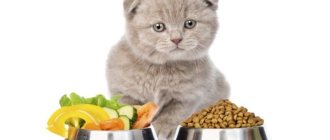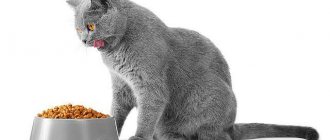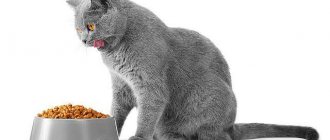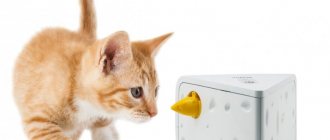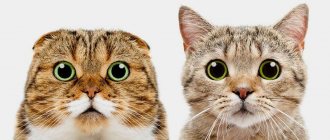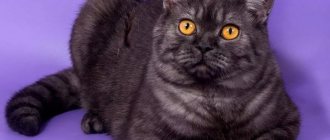While the kitten is growing, it is important to monitor its weight gain. This will allow you not to miss possible deviations in the baby’s development or health problems with his mother.
A table that shows the development norms of this breed depending on the age and gender of the pet will help you control the weight of a Scottish kitten by month.
Parameters of kittens and adult cats of the Scottish Fold breed: average weight and height
Scottish cats are medium-sized with a round, well-filled body.
With large, round, wide-set eyes. with a soft curve in the profile in the transition from the forehead to the nose. The short-haired variation has a soft coat with a pronounced undercoat, the long-haired variation is silky, not prone to matting, and longer on the frill and “pants.” The range of colors is very diverse and includes all possible color combinations. Animals of this breed come in two types: with hanging ears (folded ears) and straight, “normal” ears (straight).
Kittens of this breed are born with normal straight ears. At three to four weeks of age, their ears flatten or remain erect. By twelve weeks it is already possible to determine the quality of the kitten - show, breed or pet (show, breeding or home). Only cats with well-fitting ears are show dogs, so getting such kittens is every breeder’s dream. Straight-eared Scots are allowed to exhibit, but Champion classes are not open to all felinological systems. It is quite difficult to get a show and top class fold kitten, so they are still quite rare and, accordingly, are expensive.
When purchasing, pay attention to the flexibility of the tail and paws. Paws should not have rough or sloping toes
When running your hand along the tail, the movement should be gentle and not cause any discomfort to the kitten.
(You just need to do this very carefully!). Svetlana Zhabrovets,
Svetlana Zhabrovets
,
Based on materials from TheCatSite.com
Additional Information:
Cat scalesObesity in catsObesity treatmentFrequently asked questions about cat weight
Cats, just like humans, can experience weight problems. The most common diet-related disease is obesity. Domestic cats living in apartments lead a quiet lifestyle. Such cats often suffer from excess of normal weight, as they are limited in movement and do not lack food.
Excess fat can have a negative impact on your cat's overall health. Cats that are overweight are usually in poor shape and are prone to heart disease, arthritis and other health problems.
Chart of animal weight gain from birth to 2 years
The period of puberty is important. At this time, growth slows down. If cats come into heat 1-2 times a month, then growth may stop altogether
If you have sterilized a cat, then at first its body weight will increase slowly, but later there is a threat of obesity due to the fact that its immunity increases.
A kitten's weight is a very important aspect of its development. The baby's weight needs to be monitored for several reasons. For example, by the age of one month, a kitten can weigh up to 500 grams. If his weight differs from this indicator in the direction of decrease, this may be caused by the following reasons:
- diseases, congenital or acquired;
- numerous litters;
- the mother’s lack of a complete diet that can provide nutrition for both the cat herself and her babies.
An underweight kitten may indicate that the baby is malnourished. He becomes lethargic, sleeps a lot, and apart from the general mass of kittens. In this case, you need to increase the amount of food for the nursing cat and monitor how long the weak baby stays at her breast.
Sometimes he still managed to get comfortable, but he quickly got tired and soon fell asleep without having eaten enough. Since I closely followed the adaptation of foundlings, I immediately noticed this (literally within 24 hours). The baby had to be fed separately. I gave him a special mixture, but also tried to get him to latch on to the cat’s breast more often (the more lively brothers had to be pushed aside for a while). As a result, this baby still lagged behind the others in weight, but caught up with them in height by about a year.
If a kitten is diagnosed with any disease, then to correctly calculate the medicinal suspension you will also need to know the exact weight of the animal. Therefore, a conscientious owner always monitors this indicator.
Every caring owner should keep a kitten's weight diary. This must be done regardless of whether the kitten grows up alone or with its mother cat and brothers. It is necessary to record all weight indicators in the diary, which can later help track whether the baby is developing normally.
The weight diary can be kept in any form, as convenient for the owner. This is an ordinary notebook for me. In it I write down the date of birth of the kittens, the names I gave them, as well as everything related to caring for them. This is not only their weight, but also the dates of treatment for fleas and worms, as well as the dosage of drugs (which, by the way, depends on weight).
There are several internal and external factors influencing the growth processes of a Scottish Fold cat kitten. Internal factors are presented:
- characteristics of the breed;
- gender;
- genotype of parents;
- individual genetic characteristics;
- hormonal characteristics.
External factors affecting the growth of an animal include keeping kittens during the neonatal and suckling periods, as well as the number of individuals in the litter, quality of sleep and dietary features of a nursing cat. Animals must be provided with a completely calm, stress-free environment, good and nutritious food, as well as high-quality hygienic care.
You can feed your Scottish Fold cat both natural products and ready-made dry or wet food. The second option, according to many breeders and veterinarians, is more preferable for normal growth and development, therefore it is recommended to purchase the following ready-made diets for feeding your pet:
- AATU;
- Asana;
- Applaws;
- Canagan;
- Сarnilove;
- Farmina N{amp}amp;D;
- Gather;
- Gina Elite;
- Go Natural;
- Grandorf;
- Nature;
- Now Fresh;
- Nutram;
- Orijen;
- Pronature Nolistis;
- Savara;
- Wellness CORE.
3-6 months
You can determine how much your pet weighs using kitchen scales and later floor scales. By the age of four months, Scots weigh about 2 kilos. These are independent, active animals that need sufficient calories and vitamins. They are actively growing.
What weight category a pet occupies depends on its genetic predisposition and quality of nutrition. The owner needs to decide whether to give the baby ready-made food or prefer natural food from products that should be prepared separately for the pet without salt and spices.
What are the dangers of obesity?
You can tell that a cat is obese by its sagging belly. Because the fat layer is too thick, the costal and vertebral bones cannot be felt. An obese animal moves slowly and ignores active activities.
ATTENTION! An obese cat should be examined at a veterinary clinic for prevention, as there is a high probability of developing heart and vascular diseases, as well as inflammation of the joints.
Excess weight greatly affects the health of a British pet. The most common pathologies:
- increased blood pressure, development of atherosclerosis;
- lethargy, powerlessness, drowsiness;
- hormonal disbalance;
- blurred vision due to increased intraocular pressure;
- development of diabetes;
- the appearance of gout, osteoarthritis;
- disruption of the digestive tract;
- hard breath;
- thirst;
- deterioration of metabolism;
- weakening of the immune system.
How to weigh a kitten correctly
If the kitten is very small, then in order to weigh it, you can use a regular kitchen scale and a small box. To prevent the kitten from turning weighing into a game, the best time for the process is immediately after sleep. If the baby starts spinning and jumping, the indicators will be inaccurate. Trying to hold a playful baby with your hand can also get a distorted result.
To get the most accurate figure for the baby’s weight, you can follow two methods:
- First, weigh the box, then put the kitten in it and record the result again. Subtract the difference.
- Place the box on the scales, and only then turn them on.
They will show zeros. After this, we put the baby in a box and get the figure for his body weight. It is more convenient to weigh mobile kittens in small containers or boxes to get a more accurate result.
This way the owner will receive an exact figure in grams, which can be entered into the animal’s weight diary.
Appearance of Scottish Folds
There are developed and approved standards for the appearance of Scottish Folds. Based on them, you can distinguish a purebred Scottish Fold from an individual of mixed blood. The main breed standards are:
- massive body structure;
- large shoulders and back of the animal;
- large round head;
- straight nose with a characteristic depression in the forehead area;
- pronounced chin;
- characteristic shape of the ears.
There are also certain standards for the body of an animal:
- shortened neck;
- short legs;
- thick, plush-like fur;
- average height 27-32 cm;
- short tail.
Scottish fold kitten.
The head of a real fold-eared cat is round in shape with a high forehead and thick cheeks. As adults, some individuals may experience sagging cheeks. The ears are small in size and set far apart. They have a distinctive feature - hanging forward and down. There are three degrees of lop ears:
- single – only the tips of the ears are bent;
- double - the entire auricle is bent, there is a gap between the head and ears;
- triple - the illusion of no ears is created, they are pressed so tightly to the skull.
From birth, a kitten's ears may be straight, but by the age of five they acquire their distinctive shape, that is, they bend downwards. The eyes of fold-eared cats are round and large. The color depends directly on the color. To determine eye color, there are tables of correspondence between the color of an animal and its eyes. The tail is inactive and short. The base is thick, gradually tapering towards the end. A table of eye color and coat color matches for Scottish Fold cats is presented below.
Table of correspondence between eye color and coat color of Scottish cats.
Weight and dimensions
The weight and dimensions of the Scottish Fold depend on heredity and the number of kittens in the litter. There is a rule - the more kittens, the less their weight. The difference in weight evens out over time by six months. In the first month, a kitten gains weight by 10-20 grams per day. For proper development, a balanced diet with all the necessary substances is required. Adults are average in size for all cats. Females weigh less than males, their weight can reach 4-5 kg. The maximum weight of a cat is 8-10 kg. The average weight is 4-6 kilograms, and the height at the withers is 27-32 cm.
Tabby color Scottish fold
Origin story
The history of the Scottish Fold breed began in the mid-20th century in Scotland. On one of the farms, the cat Susie was born: the tips of her ears were curved not up, but down, which gave her face a surprised and funny expression. Susie herself had children like this from time to time. And, quite possibly, they would have remained to live and die on the farm if they had not accidentally caught the eye of a British cat breeder in 1963.
Mary Ross (that was the name of the breeder) immediately realized that this was not just a physical defect, and began to work on a new breed. As a result of mating with a British blue cat and a British shorthair kitten, kittens were born - the first representatives of the Scottish Fold.
A specific gene is responsible for lop ears - Fd. If it is present in both parents, their offspring will face serious problems with the musculoskeletal system and early death. But experimentally it turned out that mating with a Scottish Shorthair - Scottish Straight - allows you to have kittens with desirable external characteristics, but without serious health pathologies.
The Scottish Fold breed was registered in 1994.
Possible reasons why a kitten’s weight does not correspond to age standards
Determining a kitten's weight is an excellent way to assess its development. If a kitten is unable to grow and develop, this may be an indicator of serious health problems.
Scottish Fold cats, like straight-eared ones, become teenagers at 4-6 months. By this time, the females begin to estrus, and the males become eligible bachelors. At the age of more than a year, an adult gains no more than 500-700 grams up to 2.5 years.
How long your pet will gain weight is determined by its health, tendency to overeat, and mobility. But when answering the question, to what age do cats grow, we can answer unequivocally that at 2.5 years growth stops.
The main reasons for a kitten’s weight not meeting age standards are:
- Lack of nutrition. The first months of life, kittens may suffer from a lack of milk. This may be due to an unbalanced diet of the cat or a large number of brothers and sisters of the baby.
- Unbalanced regime and diet of the kitten. In particularly advanced cases, the baby’s development stops.
- Deviations associated with genetics or heredity. This applies to a greater extent to purebred kittens. It is necessary to find out what diseases can be passed on to the baby from mom and dad. If a kitten is suffering from underweight, you should check with the breeder what parameters its parents had at the same age.
- Infectious diseases and viruses. Diseases can affect the kitten’s gastrointestinal tract, which affects the absorption of food. The absorption of beneficial elements deteriorates, so the baby may not gain weight.
- Worms. At any age, helminthic infestations are dangerous for an animal, and even more so during the formation of a young organism. If a kitten is infected with worms, it will not grow well.
In the last three cases, the owner must immediately contact a veterinarian to prevent possible death of the animal or the development of diseases and transition to chronic forms.
In order for the kitten to develop normally, it is necessary to consult a specialist and follow feeding recommendations. In addition, if some deviations in the baby’s development are noticed, immediate action must be taken. The delicate body of a kitten does not yet have the immunity of an adult animal, and many infections can seriously harm it.
Scottish Fold kittens over the age of two months must already have full compliance with all breed standards. It is these pets that have the highest chances of winning in exhibition shows in the future, so you need to carefully monitor external data, as well as clearly monitor the correspondence of the animal’s height to its body weight. To determine body weight gain, it is recommended to weigh the kitten every day, strictly at the same time.
| Pet age | Body mass | |
| Male | Female | |
| Newborn | 70-140 g | 60-140 g |
| First week | 240-260 g | 110-250 g |
| Second week | 340-400 g | 140-360 g |
| Third week | 390-630 g | 200-420 g |
| Month | 540-740 g | 240-600 g |
| Two month | 1.0-1.7 kg | 400-900 g |
| Three months | 1.5-2.5 kg | 1.0-1.5 kg |
| Four months | 2.1-3.9 kg | 1.7-2.4 kg |
| Five months | 2.6-4.3 kg | 2.2-2.9 kg |
| Six months | 3.0-5.4 kg | 2.3-3.6 kg |
| Seven months | 3.3-5.6 kg | 2.4-3.9 kg |
| Eight months | 3.5-6.0 kg | 2.5-4.1 kg |
| Nine month | 3.8-6.4 kg | 2.5-4.3 kg |
| Ten months | 4.1-6.7 kg | 2.5-4.4 kg |
| Eleven months | 4.3-6.8 kg | 2.5-4.5 kg |
| One year | 4.5-7.0 kg | 2.5-4.6 kg |
Possible reasons why a kitten’s weight does not correspond to age standards
Determining a kitten's weight is an excellent way to assess its development. If a kitten is unable to grow and develop, this may be an indicator of serious health problems.
Scottish Fold cats, like straight-eared ones, become teenagers at 4-6 months. By this time, the females begin to estrus, and the males become eligible bachelors. At the age of more than a year, an adult gains no more than 500-700 grams up to 2.5 years.
How long your pet will gain weight is determined by its health, tendency to overeat, and mobility. But when answering the question, to what age do cats grow, we can answer unequivocally that at 2.5 years growth stops.
The main reasons for a kitten’s weight not meeting age standards are:
- Lack of nutrition. The first months of life, kittens may suffer from a lack of milk. This may be due to an unbalanced diet of the cat or a large number of brothers and sisters of the baby.
- Unbalanced regime and diet of the kitten. In particularly advanced cases, the baby’s development stops.
- Deviations associated with genetics or heredity. This applies to a greater extent to purebred kittens. It is necessary to find out what diseases can be passed on to the baby from mom and dad. If a kitten is suffering from underweight, you should check with the breeder what parameters its parents had at the same age.
- Infectious diseases and viruses. Diseases can affect the kitten’s gastrointestinal tract, which affects the absorption of food. The absorption of beneficial elements deteriorates, so the baby may not gain weight.
- Worms. At any age, helminthic infestations are dangerous for an animal, and even more so during the formation of a young organism. If a kitten is infected with worms, it will not grow well.
In the last three cases, the owner must immediately contact a veterinarian to prevent possible death of the animal or the development of diseases and transition to chronic forms.
In order for the kitten to develop normally, it is necessary to consult a specialist and follow feeding recommendations. In addition, if some deviations in the baby’s development are noticed, immediate action must be taken. The delicate body of a kitten does not yet have the immunity of an adult animal, and many infections can seriously harm it.
Scottish Fold kittens over the age of two months must already have full compliance with all breed standards. It is these pets that have the highest chances of winning in exhibition shows in the future, so you need to carefully monitor external data, as well as clearly monitor the correspondence of the animal’s height to its body weight. To determine body weight gain, it is recommended to weigh the kitten every day, strictly at the same time.
| Pet age | Body mass | |
| Male | Female | |
| Newborn | 70-140 g | 60-140 g |
| First week | 240-260 g | 110-250 g |
| Second week | 340-400 g | 140-360 g |
| Third week | 390-630 g | 200-420 g |
| Month | 540-740 g | 240-600 g |
| Two month | 1.0-1.7 kg | 400-900 g |
| Three months | 1.5-2.5 kg | 1.0-1.5 kg |
| Four months | 2.1-3.9 kg | 1.7-2.4 kg |
| Five months | 2.6-4.3 kg | 2.2-2.9 kg |
| Six months | 3.0-5.4 kg | 2.3-3.6 kg |
| Seven months | 3.3-5.6 kg | 2.4-3.9 kg |
| Eight months | 3.5-6.0 kg | 2.5-4.1 kg |
| Nine month | 3.8-6.4 kg | 2.5-4.3 kg |
| Ten months | 4.1-6.7 kg | 2.5-4.4 kg |
| Eleven months | 4.3-6.8 kg | 2.5-4.5 kg |
| One year | 4.5-7.0 kg | 2.5-4.6 kg |
Feeding in the first year of life
Like kittens of other breeds, Scottish kittens consume only mother's milk up to 3 weeks. If an accident occurs, for example, a Scottish cat died during childbirth, from a malignant disease or due to accidental poisoning, or ran out onto the roadway, refused to feed the kittens, or other accidents, then orphaned kittens will benefit from milk formulas that are extremely close in composition to cat milk.
Good products are produced, for example, by Royal Canin, which specializes mainly in dog and cat food. Manufacturers of such products ensure that the fat content does not exceed 10%, and the vitamin content of the compositions is sufficient for the growing body of dogs and cats.
If there is no specialized store or veterinary hospital with a mini-store nearby where you can choose food for any kittens and puppies, act independently. To reduce the fat content, village (farm) milk is diluted in half with boiled water or cleared of cream and given to a newborn kitten to taste. They begin to feed it off, gradually reducing the number of meals per day from day to day, but increasing the volume of each complementary food.
You can take the nutrition of any average outbred kitten as a basis - all kittens consume approximately the same amount of milk. A specific breed - the same Scottish cats - requires its own amount of food in the first days and weeks of life, but you can save the life of your ward and let him grow up, adhering to the norm of “street” kittens.
The main thing is not to overfeed, not to underfeed, and not to forget about feeding regularly, otherwise the kitten will be late in gaining weight and will not develop properly, which will lead to illness and premature death later.
Deviations from the norm
The first six months of a kitten's life are the most active in terms of growth. Accordingly, if the baby is healthy and develops normally, he will regularly gain weight:
Before the baby turns 1 month old, he rapidly gains weight - about 15 g per day. At the same time, by the end of the 1st week, the kitten should double its birth weight. Weigh him daily during this period. From 1 to 2 months, weight gain occurs systematically, on average 100–150 g per week. Weigh the baby once every 3 days. After 2 months, weight gain varies from person to person. It depends on the breed and nutrition of the animal. He is weighed weekly for up to 6 months, then once a month for up to a year.
It is important that there is weight gain. If it is absent, you should contact your veterinarian to find out the reasons.
The basic physical parameters of representatives of the Scottish Fold breed, including body weight, the size of the animal as a whole, as well as the size and appearance of individual parts of the body, must fully correspond to the age of the pet. The presence of serious deviations from the norm most often indicates pathological changes and malfunctions in the body.
Sometimes animals between seven and nine months of age also stop gaining weight or noticeably reduce the weight they have gained. This situation is usually associated with the process of puberty and hormonal changes in the body. Adult cats often do not gain weight for a similar reason.
It is important to remember that early matings have very serious consequences, which have an extremely negative impact on the fragile body of a purebred Scottish Fold cat, and also provoke a stop in the growth and development of the pet. Deviations from the norm can also manifest themselves in the form of obesity, overweight in a cat
Most often, such problems arise due to overfeeding of a pet or non-compliance with the feeding regime. It is especially important to monitor weight in castrated cats and sterilized Scottish Fold cats.
Deviations from the norm can also manifest themselves in the form of obesity, overweight in a cat or cat. Most often, such problems arise due to overfeeding of the pet or non-compliance with the feeding regime.
It is especially important to monitor weight in castrated cats and sterilized Scottish Fold cats.
Diseases
Judging by the reviews of owners of Scottish Fold cats, their pets have fairly strong immunity and live a long time (15 years or even more). But the gene responsible for cute ears also gave the animals some unpleasant gifts, namely: problems with the musculoskeletal system. Moreover, these problems appear with age and it is almost impossible to predict whether this will happen or not. A well-designed diet, selection of a good vitamin and mineral supplement, and monitoring the animal’s weight can help as preventive measures.
Due to the structure of the ears, parasites and pathogenic bacteria often get inside. Look into your cat's ear often, and if you suspect something is wrong, take your pet to the veterinarian.
Expert opinion
Dusheba Vera Ivanovna
In 2010, she graduated from the Moscow State Academy of Veterinary Medicine named after K.I. Scriabin with honors, specializing in veterinary medicine. I regularly attend veterinary conferences, congresses, and webinars.
If your Scottish Fold has become unusually lethargic and apathetic, refuses to eat, there is blood in the feces and urine, and there is a stink coming from the mouth, this indicates some kind of disease. Don't put off visiting the veterinary clinic!
KITTEN IS NOT GAINING WEIGHT. WHAT TO DO?
Compare the weight and age of the kitten using the table. With proper care of the kitten, weight indicators should be normal. Although the development of kittens of each breed, and each animal can be individual.
If your kitten is not gaining weight, there may be several reasons. Firstly, there are many kittens in a litter, for example 5-6 or more, and then, perhaps, the baby simply does not have enough milk or a free nipple. Make sure he eats, put him close to his mother cat more often.
If there are really a lot of kittens, it is necessary to feed the kittens with special milk for kittens (can be bought at a pet store) from a pipette or pacifier.
If even after this the kitten does not gain weight, it is most likely sick and you should urgently contact a veterinarian.
After switching to dry food, kittens from a large litter most often reach average weight.
ADULT ANIMALS. HOW TO GAIN WEIGHT FOR A CAT?
It happens that kittens at 7-9 months stop gaining weight or even lose it altogether. This is most likely due to the fact that at this time they go through puberty and hormonal changes.
An adult cat does not gain weight for the same reason. If your cat's estrus is long and frequent, be sure to give sedatives, but do not breed animals before a year (only on the recommendation of a veterinarian). Early matings have serious consequences. See the table for the normal weight of a cat. With proper care and maintenance, the weight should correspond to age and breed.
Kitten weight table by month
The weight of the kitten by month is indicated separately for the cat and for the cat.
- weight and age of the kitten by month
- maine coon cat weight
- maine coon cat weight
- british cat weight
- british cat weight
- Scottish cat weight
- Scottish cat weight
| 1 | 2 | 3 | 4 | 5 | 6 | 7 |
| Newborn kitten weight | 120-140 | 120-160 | 60-140 | 70-140 | 60-140 | 70-140 |
| Kitten weight 1 week | 180-230 | 200-260 | 110-250 | 240-260 | 110-250 | 240-260 |
| Kitten weight 2 weeks | 280-340 | 300-360 | 150-360 | 340-400 | 140-360 | 340-400 |
| Kitten weight 3 weeks | 420-550 | 440-600 | 210-420 | 400-630 | 200-420 | 390-630 |
| Kitten weight 4 weeks/1 month | 560-680 | 630-750 | 250-600 | 550-740 | 240-600 | 540-740 |
| Kitten weight at 2 months | 1,1-1,4 | 1,2-1,5 | 450-900 | 1,0-1,7 | 400-900 | 1,0-1,7 |
| Kitten weight at 3 months | 1,7-2,3 | 1,8-2,3 | 1,0-1,5 | 1,5-2,5 | 1,0-1,5 | 1,5-2,5 |
| Kitten weight at 4 months | 2,7-3,6 | 3,0-3,8 | 1,7-2,4 | 2,1-3,9 | 1,7-2,4 | 2,1-3,9 |
| Kitten weight at 5 months | 2,9-3,9 | 3,2-5,5 | 2,2-2,9 | 2,6-4,3 | 2,2-2,9 | 2,6-4,3 |
| Kitten weight at 6 months | 3,2-4,0 | 3,9-6,0 | 2,3-3,6 | 3,0-5,4 | 2,3-3,6 | 3,0-5,4 |
| Kitten weight at 7 months | 3,5-4,1 | 4,2-6,5 | 2,4-3,9 | 3,3-5,6 | 2,4-3,9 | 3,3-5,6 |
| Kitten weight at 8 months | 3,8-4,3 | 4,5-6,9 | 2,5-4,1 | 3,5-6,0 | 2,5-4,1 | 3,5-6,0 |
| Kitten weight at 9 months | 4,1-5,0 | 5,0-7,0 | 2,5-4,3 | 3,8-6,4 | 2,5-4,3 | 3,8-6,4 |
| Kitten weight at 10 months | 4,2-5,5 | 5,2-7,7 | 2,5-4,4 | 4,1-6,7 | 2,5-4,4 | 4,1-6,7 |
| Kitten weight at 11 months | 4,3-6,0 | 5,7-8,0 | 2,5-4,5 | 4,3-6,8 | 2,5-4,5 | 4,3-6,8 |
| Kitten weight at 12 months/1 year | 4,5-6,3 | 5,7-9,0 | 2,5-4,6 | 4,5-7,0 | 2,5-4,6 | 4,5-7,0 |
| Adult cat weight and adult cat weight | 4,5-7,5 | 5,7-10,0 | 2,5-5,5 | 4,5-8,0 | 2,5-5,5 | 4,5-8,0 |
| Weight of castrated/sterilized cats and female cats | 4,5-10 | 5,7-12,0 | 2,5-6,0 | 4,5-9,5 | 2,5-5,8 | 4,5-9,0 |
We will also consider and compare the weight of cats of different popular breeds: Bengal cat, Siberian cat, Abyssinian cat, Russian Blue cat, Bobtail, Norwegian forest cat, Siamese cat and many others.
| 3.4-6.1 |
| 4.0-7.2 |
| 3.1-5.5 |
| 3.8-6.9 |
| 3.6-6.5 |
| 3.2-5.8 |
| 3.1-5.5 |
| 4.0-7.2 |
| 3.6-6.5 |
| 3.6-6.5 |
| 3.0-6.8 |
| 3.1-5.5 |
| 3.4-6.1 |
| 3.2-5.8 |
| 3.8-6.8 |
| 2.8-5.1 |
| 3.0-5.4 |
| 3.5-6.3 |
| 2.7-4.8 |
| 3.2-5.8 |
| 3.5-6.3 |
| 3.2-5.8 |
| 5.8-10.5 |
| 2.5-4.5 |
| 3.2-5.8 |
| 3.0-5.3 |
| 4.4-7.9 |
| 3.8-6.8 |
| 2.5-4.5 |
| 5.0-9.0 |
| 3.6-6.6 |
| 3.1-5.5 |
| 4.0-7.2 |
| 2.5-4.5 |
| 3.4-6.1 |
| 3.25.8 |
| 3.4-6.1 |
| 4.0-7.2 |
| 3.5-6.3 |
| 3.3-5.9 |
| 4.0-7.2 |
| 3.8-6.9 |
| 3.0-7.2 |
| 3.8-6.8 |
| 2.8-5.1 |
| 2.8-5.1 |
Track your pet's weight and make sure he grows up healthy!
- How to make a cat house with your own hands
- How to train a kitten to use a litter box
- How to accustom a kitten to a scratching post
| In our nursery you can “buy a real British kitten.” We have many different colors, we will help you choose and answer all your questions! |
How to weigh
Determining the weight of a kitten at first glance seems somewhat complicated. However, everything is quite simple.
Methods:
- The first method is the most common, weighing on an electronic kitchen scale. Such scales show the result quite accurately, making weighing kittens from 0 months old very easy and simple.
- The second method also has the right to life. Here it is suggested to use commercial hand scales with a hook. To measure mass this way, you will need a bag or some other container to place the cat in. The container is pre-weighed separately. This method of measurement is far from the most accurate.
- The third method is more likely for adult animals whose weight is from 1 kg. You need floor scales on which you weigh yourself and then weigh yourself with your pet. The difference between the first and second weighing will be equal to the weight of the cat.
- The surest, but not the most convenient way, is to weigh the kitten in a veterinary clinic on special scales.
What are the norms for weight gain for kittens?
The first six months of a kitten's life are the most active in terms of growth. Accordingly, if the baby is healthy and develops normally, he will regularly gain weight:
Before the baby turns 1 month old, he rapidly gains weight - about 15 g per day. At the same time, by the end of the 1st week, the kitten should double its birth weight. Weigh him daily during this period. From 1 to 2 months, weight gain occurs systematically, on average 100–150 g per week. Weigh the baby once every 3 days. After 2 months, weight gain varies from person to person. It depends on the breed and nutrition of the animal. He is weighed weekly for up to 6 months, then once a month for up to a year.
It is important that there is weight gain. If it is absent, you should contact your veterinarian to find out the reasons.
Since there are no exact indicators of body weight gain (much depends on the individual characteristics of the animal, its living conditions and diet), the owner should focus on the average weight standards for kittens.
Table: average body weight of kittens in the first 6 months of life
| Age | Weight |
| 1–6 days | 70–130 g |
| 7 days | 85–200 g |
| 7–14 days | 225–400 g |
| 14–21 days | 285–500 g |
| 1 month | 500–750 g |
| 2 months | 1000–1500 g |
| 3 months | 1700–2300 g |
| 4 months | 2500–3600 g |
| 5 months | 3100–4200 g |
| 6 months | 3500–4800 g |
Short-term stabilization of weight in a kitten
The phenomenon of short-term weight stabilization often occurs. There is no need to panic if the kitten’s weight gain “frozen” for several days, and then continues in the same progression.
Such an anomaly can manifest itself at any time stage of the baby’s life. It often occurs when there is a transition from breastfeeding to regular food (dry food or natural food). This is due to the fact that the baby’s body goes through a period of adaptation to receiving new nutrients.
However, you should worry if there are no changes for more than a few days (for example, a week). This may mean that the kitten is malnourished or sick or infected with parasites. You should visit a veterinarian as soon as possible if, after weight stagnation, body weight begins to decrease rather than increase.
Table: kitten weights by month (values for popular breeds)
| Kitten age | Maine Coon cat weight (g) | Catamein Coon weight (g) | British cat weight (g) | British cat weight (g) | Scottish cat weight (g) | Scottish cat weight (g) |
| Newborn kitten | 120–140 | 120–160 | 60–140 | 70–140 | 60–140 | 70–140 |
| 1 Week | 180–230 | 200–260 | 110–250 | 240–260 | 110–250 | 240–280 |
| 2 week | 280–340 | 400–360 | 150–360 | 340–400 | 140–360 | 340–400 |
| 3 week | 420–550 | 440–600 | 210–420 | 400–630 | 200–420 | 390–630 |
| 4 week | 560–680 | 630–750 | 250–600 | 550–740 | 240–600 | 540–740 |
| 2 months | 1100–1400 | 1200–1500 | 450–900 | 1000–1700 | 400–900 | 1000–1700 |
| 3 months | 1700–2300 | 1800–2300 | 1000–1500 | 1500–2500 | 1000–1500 | 1500–2500 |
| 4 months | 2700–3600 | 3000–3800 | 1700–2400 | 2100–3900 | 1700–2400 | 2100–3900 |
| 5 months | 2900–3900 | 3000–5500 | 2200–2900 | 2600–4300 | 2200–2900 | 2600–4300 |
| 6 months | 3200–4000 | 3900–6000 | 2300–3600 | 3000–5400 | 2300–3600 | 3000–5400 |
| 7 months | 3500–4100 | 4200–6500 | 2400–3900 | 3300–5600 | 2400–3900 | 3300–5600 |
| 8 months | 3800–4300 | 4500–6900 | 2500–4100 | 3500–6000 | 2500–4100 | 3500–6000 |
| 9 months | 4100–5000 | 5000–7000 | 2500–4300 | 3800–6400 | 2500–4300 | 3800–6400 |
| 10 months | 4200–5500 | 5200–7700 | 2500–4400 | 4100–6700 | 2500–4400 | 4100–6700 |
| 11 months | 4300–6000 | 5700–8000 | 2500–4500 | 4300–6800 | 2500–4500 | 4300–6800 |
| 12 months | 4500–6300 | 5700–9000 | 2500–4600 | 4500–7000 | 3500–4600 | 4500–7000 |
How to determine weight standards for a mongrel kitten
When it is not possible to determine what breed a kitten is, it is necessary to use average indicators. The size of the baby will change in accordance with its development. There are a number of factors that allow you to predict a kitten’s weight gain. For example, when he switches from breast milk to a normal diet, the weight may decrease slightly.
After the 6th month of life, weight gain is not of decisive importance. If the cat is active, eats well, and has no problems visiting the litter box, then there is no need to worry too much. The veterinarian should be observed on a schedule determined by the doctor (basically it coincides with the vaccination schedule).
Having mongrel cats and a dog adopted from the street, I regularly visit the veterinarian. All my animals have veterinary passports, are vaccinated and sterilized. This way I protect not only them, but also my family. After all, some diseases (and at least the same worms) can be transmitted to humans. Since my children play with animals, I have a strict order in this matter.
The first days of a kitten
In the first weeks, the young fluffy eats only mother's milk, and per day gains from 10 to 20 grams. So, if the weight after birth is known, then in the coming days you can estimate it with a certain accuracy without weighing.
At this time, babies are still blind, so they move little, staying close to the cat’s nipples. This circumstance contributes to the accumulation of mass, since the cub receives calories, but almost does not consume them. In addition, young creatures mainly sleep, so that by the time they are half-mooned they often weigh about 250 grams.
In order for the kittens to develop properly, the owner must be attentive to the optimality of the menu and the quality of the products that the mother cat eats. So you should purchase specially formulated food for her, and you should not set food restrictions for her.
By the half-month of life, babies have eyes. It is during this period that young fluffies begin to master movement on their own little paws. By this time, the baby’s weight can reach 420 grams. Just at this time, when kittens learn to walk, play and have fun, their appetite increases, so that their weight gain accelerates.
From the end of the third week, it is allowed to begin introducing the kittens to complementary foods a little at a time. But you should be aware that from the very beginning of complementary feeding this should be done using high-quality products.
The best choice would be specialized bagged food and canned food for kittens. It is not advisable to purchase cheap food, since it provokes the appearance of all kinds of diseases, for example, kidney stones.
Weight and size standards
The weight table shows the maximum and minimum values for males and females:
| Kitten age | Weight, g/kg | |
| Cat | Cat | |
| Newborn | 60—140 | 70—140 |
| 1 Week | 110—250 | 240—260 |
| 2 | 150—360 | 340—400 |
| 3 | 210—420 | 400—630 |
| 4 | 250—600 | 550—740 |
| 5—9 | 450—900 | 1,0—1,7 |
| 10—14 | 1,0—1,5 | 1,5—2,5 |
| 15—18 | 1,7—2,4 | 2,1—3,9 |
| 19—23 | 2,2—2,9 | 2,6—4,3 |
| 24—28 | 2,3—3,6 | 3,0—5,4 |
| 7 months | 2,4—3,9 | 3,3—5,6 |
| 8 | 2,5—4,1 | 3,5—6,0 |
| 9 | 2,5—4,3 | 3,8—6,4 |
| 10 | 2,5—4,4 | 4,1—6,7 |
| 11 | 2,5—4,5 | 4,3—6,8 |
| 1 year | 2,5—4,6 | 4,5—7,0 |
| Adults | 2,5—5,5 | 4,5—8,0 |
| Neutered/neutered | 2,5—6,0 | 4,5—9,5 |
First days
Thanks to mother's milk, babies grow very quickly.
British kittens, compared to other cat breeds, are born large, with a healthy newborn weighing from 60 to 140 grams. The first days after birth are very important for a kitten, which means it must receive the required amount of vitamins through its mother's milk. If a kitten was born with too little weight or, conversely, too much weight, this means that there are disruptions in the development of the body, the presence of some kind of disease. In this case, you need to contact a veterinarian. Healthy pets gain weight very well in the first seven days; they become 1.5 times heavier.
Second week
The weight of a British cat during this period reaches 210 grams, and large ones can reach a maximum weight of 400 grams. Up to a month, kittens become more mobile, and the most active, early ones, can open their eyes. Starting from 3-4 weeks, you can start giving complementary foods, depending on the development and growth rate of the baby. By the first month, the Briton gains another 250 grams, and large ones grow during this time and can weigh about half a kilogram.
1-2 months
By two months, babies can eat special food that will help them develop further.
At one month old, the babies have already opened their eyes and become active and mobile.
During this period, it is important to monitor the balanced and proper nutrition of the British; you need to observe how he eats and what his reaction is to food. If you feed with food, then you need to choose a very good one, since unsuitable food can cause urolithiasis. By the end of the first month, the average weight of a kitten should reach 600 grams, within a week it gains another 100 grams, by the second month it should weigh from 700 grams to 1.5 kilograms
By the end of the first month, the average weight of a kitten should reach 600 grams, within a week it gains another 100 grams, and by the second month it should weigh from 700 grams to 1.5 kilograms.
3-4 months
At this age, the body weight of kittens depends on gender, the British female grows up to 1.5 kg, and the male up to 2 kilograms. With a diet enriched with vitamins, kittens grow 100 grams daily. At the 4th month of their life, they look like adult pets, the body becomes prominent and the structure is more muscular, the average weight of a female ranges from 1.7 to 2.4 kg, a male 2.1-3.9. The weight of a British kitten at 4 months depends not only on nutrition, but also on heredity, so from this age its size varies up to 2 kilograms. If the kitten's weight reaches 4 kilograms at 4 months, you need to consult a veterinarian.
Up to six months
A six-month-old pet becomes quite large and weighty.
At 5 months, the kitten increases its weight by 1.5-2 times, this is half the body weight of this breed. The norm during this period for females is 2.2-2.9 kg, for males 2.6-4.5 kilograms. In six months, a cat gains from 3 kg to 5.4 kg, and the weight of a British cat is 2.3-3.6 kilograms. Pets of this breed are quite large pets, the main thing is not to overfeed them, this has a bad effect on their development.
UK sizes per year
During this period, the cat reaches a size of 4.5-8 kg, and cats - 2.5-5.5 kg. The maximum weight that cats of this breed can reach at 1 year is 7 kilograms. The weight of a castrated male at this age is 4.5-9.5 kg, and a sterilized female is from 2.5 to 6 kg. Pets should be weighed at the same time; normally, they should gain 100 g daily, the average weight of an adult cat reaches 8 kilograms, cats - 5.5 kilograms.
Recommendations for introducing complementary foods
For meat products, it is recommended to give preference to boiled or pre-frozen beef.
- Initially, you can put small pieces directly into the kitten’s mouth, and then gradually begin to accustom him to the plate. At 2.5 months, the pet should already be able to eat on its own.
- It is not recommended to give several different foods at once - this can lead to constipation. Also, if an animal develops an allergy, it will be difficult to determine what exactly. You can detect an allergic reaction by lifting the kitten's tail - there will be yellowish stains under it.
- The best source of calcium is cream with 10-15% fat content - it can be given 2 times a week in small portions from 4 weeks.
You should not feed your kitten canned food, purees, pasta or minced meat - these products have a negative effect on the digestive tract and can cause diarrhea.
At 1 year of age, you can stop monitoring your pet’s weight every month—after that, there won’t be much noticeable changes in your pet’s size or weight.
If the weight of a fold-eared cat is significantly lower than the specified minimum values, and tests do not reveal problems in the digestive tract, the doctor will help balance the diet and prescribe a vitamin complex.

